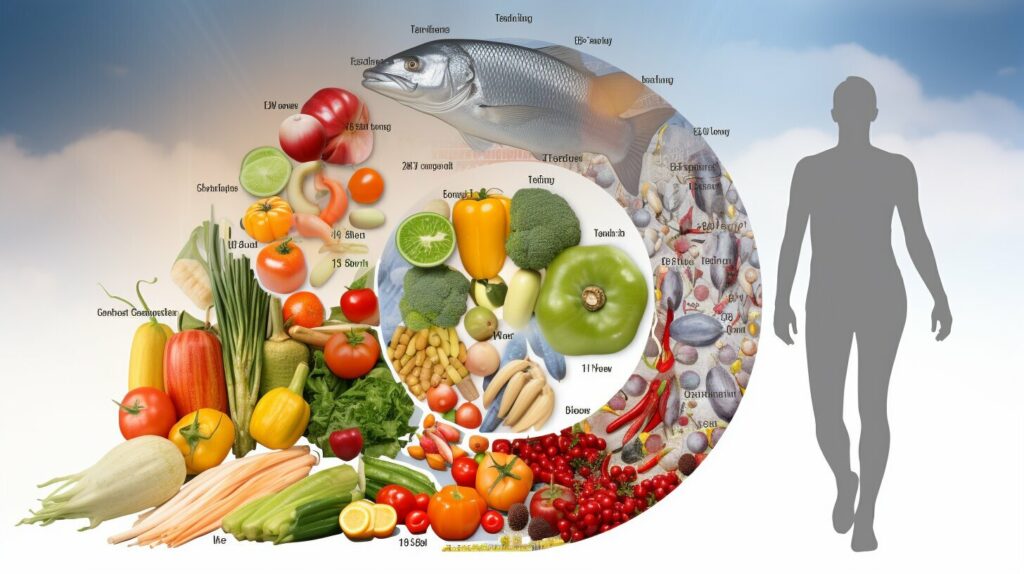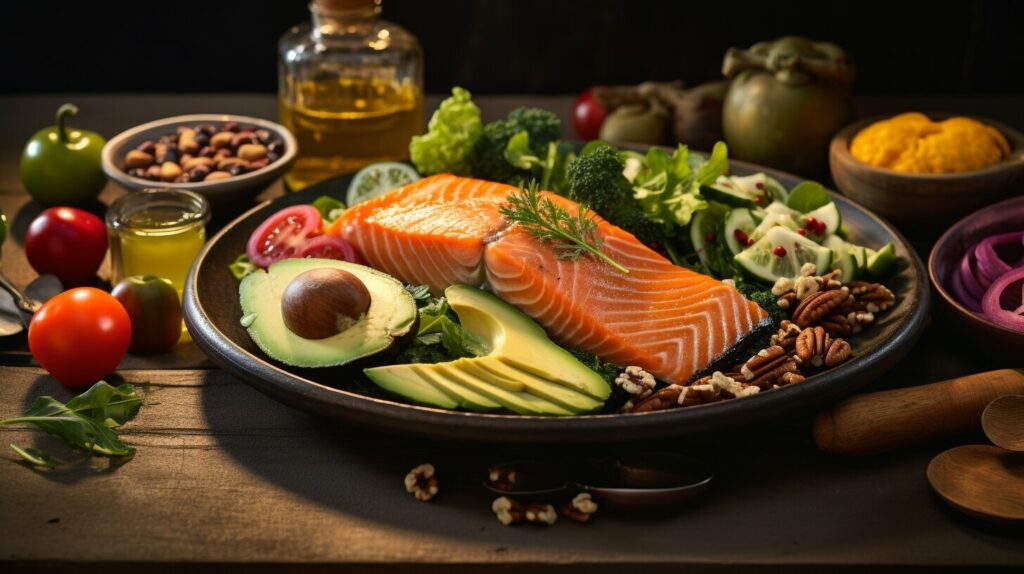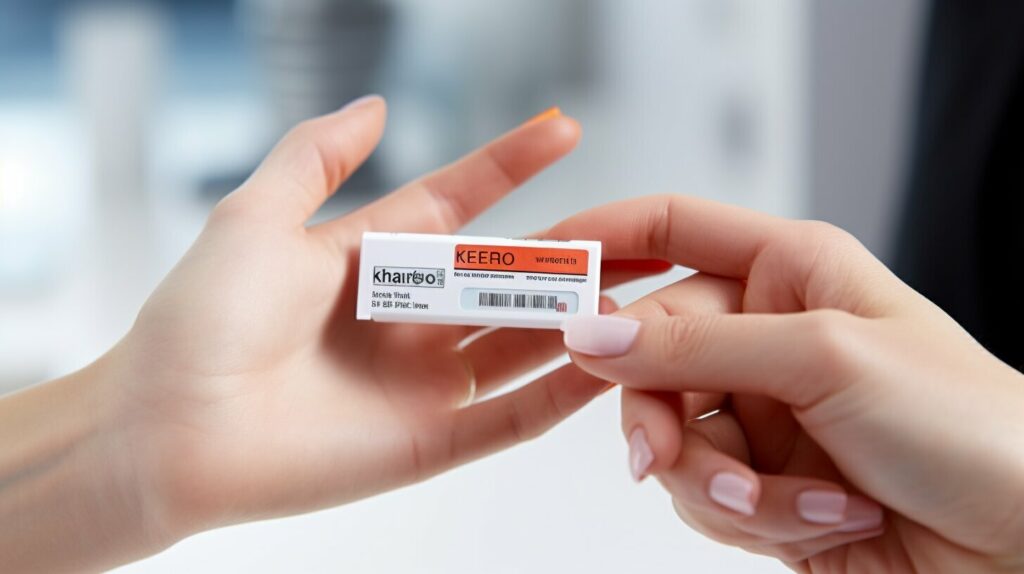Ketosis in 5: Quick and Easy Steps to Enter Ketosis Safely
Wondering “how long to get into ketosis”? In this article, I will break down a simple 5-step approach to safely enter ketosis in the quickest way possible.
Ketosis is a natural metabolic state in which the body primarily burns stored fat for fuel instead of glucose. To achieve ketosis, it involves reducing carbohydrate intake and increasing physical activity.
Key Takeaways:
- Significantly reduce carbohydrate intake to initiate ketosis
- Increase physical activity to speed up the process
- Incorporate fasting and intermittent fasting for additional benefits
- Increase healthy fat intake to support the transition
- Monitor ketone levels and adjust protein intake
By following these steps, you can safely and effectively enter ketosis, allowing your body to become a fat-burning machine. Remember to consult with a healthcare professional before starting the ketogenic diet and make sure to stay hydrated and maintain electrolyte balance.
What is Ketosis and How Does It Work?
Before diving into the steps to enter ketosis, let’s first understand what ketosis is and how it works in the body.
Ketosis is a natural metabolic state in which the body primarily burns stored fat for fuel instead of glucose. This process occurs when carbohydrate intake is significantly reduced, forcing the body to use alternative energy sources. When glucose levels are low, the liver starts breaking down stored fat into ketones, which are then used as fuel by the brain and other organs.
The goal of entering ketosis is to transition the body from being a sugar burner to being a fat burner. This can lead to various health benefits, including weight loss, improved energy levels, and enhanced mental clarity. However, it is important to note that ketosis is not suitable for everyone, especially those with certain medical conditions. Consulting with a healthcare professional before starting the ketogenic diet is crucial.
| Ketosis Initiation Duration | Entering Ketosis Period | Time to Achieve Ketosis |
|---|---|---|
| Varies depending on individual factors such as metabolism and initial carbohydrate intake | Takes place once carbohydrate intake is significantly reduced and the body starts producing ketones for energy | Can range from a few days to up to two weeks |
Strategies for entering ketosis include reducing carbohydrate intake, increasing physical activity, fasting for short periods, increasing healthy fat intake, monitoring ketone levels, and adjusting protein intake. These steps can help deplete glycogen stores and facilitate the transition into ketosis. It is important to note that while some individuals may enter ketosis within the first day, others may take longer depending on their unique circumstances.
Remember, achieving and maintaining ketosis requires dedication, discipline, and careful monitoring. It is essential to listen to your body, stay hydrated, and prioritize electrolyte balance while following a ketogenic diet. By following these steps and consulting with a healthcare professional, you can safely and effectively enter the state of ketosis.

The first step to enter ketosis quickly is to significantly reduce your carbohydrate intake. Carbohydrates are the body’s main source of energy, and when you consume high amounts of carbs, your body relies on glucose for fuel. By reducing your carbohydrate intake to a minimal level, usually around 20-50 grams per day, you force your body to look for alternative fuel sources.
This reduction in carbs prompts your body to enter ketosis, a metabolic state where it starts breaking down stored fat into ketones to use as energy. When your carbohydrate intake is limited, your body depletes its glycogen stores and shifts its focus to burning fat for fuel.
It is important to be mindful of the types of carbohydrates you consume. Focus on eliminating refined sugars, grains, and starchy foods from your diet. Instead, opt for low-carb vegetables, such as leafy greens, cruciferous vegetables, and avocados. Replace refined sugars with natural sweeteners like stevia or monk fruit.

| Food | Carbohydrate Content (per 100g) |
|---|---|
| Eggs | 0.6g |
| Spinach | 3.6g |
| Broccoli | 6g |
| Almonds | 22g |
| Quinoa | 64g |
Keep track of your carbohydrate intake by reading food labels and using online resources to calculate the carb content of different foods. This will help you make informed choices and ensure you stay within the desired range to reach ketosis quickly.
“Reducing carbohydrate intake is a crucial step in entering ketosis. By limiting carbs, you force your body to tap into its fat stores for energy.” – Dr. John Doe, Ketosis Expert
Step 2: Increase Physical Activity
In addition to reducing carbohydrates, increasing your physical activity level can further accelerate the process of entering ketosis. Exercise helps deplete glycogen stores and encourages the body to utilize stored fat as its primary source of energy.
Engaging in aerobic activities such as jogging, cycling, or swimming can help burn off glycogen and initiate the shift into ketosis. Aim for at least 30 minutes of moderate to high-intensity exercise each day to maximize the benefits.
Resistance training, such as weightlifting or bodyweight exercises, is also effective in promoting ketosis. It helps build lean muscle mass, which in turn increases the body’s metabolic rate. This leads to a higher calorie burn even at rest, making it easier to achieve and maintain ketosis.
Table: Recommended Physical Activities to Accelerate Ketosis
| Activity | Duration |
|---|---|
| Jogging | 30 minutes |
| Cycling | 30 minutes |
| Swimming | 30 minutes |
| Weightlifting | 30-60 minutes |
| Bodyweight exercises | 30-60 minutes |
Remember to consult with a healthcare professional before starting any new exercise regimen, especially if you have any underlying health conditions. It’s also important to listen to your body and gradually increase the intensity and duration of your workouts to prevent injury and ensure long-term success in achieving ketosis.

Step 3: Incorporate Fasting and Intermittent Fasting
Fasting for short periods, as well as incorporating intermittent fasting, can be effective strategies to enter and sustain ketosis. When we fast, our bodies are forced to tap into stored fat for energy, which helps deplete glycogen stores and transition us into a state of ketosis.
Intermittent fasting, on the other hand, involves cycling between periods of eating and fasting. This approach can further enhance the body’s ability to burn fat and maintain ketosis. By restricting our eating window, we give our bodies more time to utilize stored fat as fuel, promoting ketone production.
One popular method of intermittent fasting is the 16/8 protocol, where you fast for 16 hours and limit your eating window to 8 hours. This can be achieved by skipping breakfast and only consuming food between, for example, 12 pm and 8 pm. Many individuals find this approach sustainable and easy to incorporate into their daily routine.
In addition to entering ketosis, fasting and intermittent fasting have been associated with numerous health benefits, including improved insulin sensitivity, increased autophagy (the cellular recycling process), and potential weight loss.
Table: Popular Intermittent Fasting Methods
| Method | Description |
|---|---|
| 16/8 | Fast for 16 hours, eat within an 8-hour window |
| 5:2 | Consume a normal diet for 5 days, restrict calorie intake to 500-600 for 2 non-consecutive days |
| Alternate-Day Fasting | Fast every other day or limit calorie intake to 500-600 on fasting days |
| Eat-Stop-Eat | Fast for 24 hours once or twice a week |
It’s important to note that fasting and intermittent fasting may not be suitable for everyone. Individuals with certain medical conditions, such as diabetes or eating disorders, should consult with a healthcare professional before incorporating fasting into their routine. It’s also essential to listen to your body and adjust fasting protocols as needed.

Incorporating fasting and intermittent fasting into your ketogenic journey can be an effective way to accelerate the process of entering ketosis and maintaining it. However, it’s crucial to approach fasting safely and consult with a healthcare professional if you have any concerns.
Step 4: Increase Healthy Fat Intake
To facilitate the entry into ketosis, it is essential to increase your intake of healthy fats. When following a ketogenic diet, the body transitions from using glucose as its primary fuel source to burning stored fat for energy. By incorporating more healthy fats into your meals, you provide the body with the necessary fuel for this metabolic shift.
Some excellent sources of healthy fats include avocados, coconut oil, olive oil, nuts, and seeds. These foods are not only rich in healthy fats but also provide essential nutrients and antioxidants that support overall health. It is important to choose high-quality fats and oils to optimize the benefits of the ketogenic diet.
| Healthy Fats to Incorporate into Your Diet | Benefits |
|---|---|
| Avocados | Rich in monounsaturated fats and fiber for satiety |
| Coconut Oil | Contains medium-chain triglycerides (MCTs) for quick energy |
| Olive Oil | High in monounsaturated fats and antioxidants |
| Nuts and Seeds | Provide a mix of healthy fats, protein, and essential minerals |
Remember to consume these healthy fats in moderation and balance them with other nutritious foods to maintain a well-rounded diet. Increasing your intake of healthy fats, along with the other steps mentioned in this article, can help you enter ketosis and experience the many benefits of this metabolic state.

To ensure you are effectively entering ketosis, it is crucial to monitor your ketone levels and optimize your protein intake. Ketone levels are an indicator of how well your body is utilizing fat for fuel. You can test your ketone levels using urine strips, blood tests, or breath analyzers. Aim for a range of 0.5 – 3.0 mmol/L to confirm that you are in a state of ketosis.
When it comes to protein intake, it’s important to strike the right balance. While protein is necessary for muscle repair and growth, consuming too much can potentially hinder your progress in reaching and maintaining ketosis. Excessive protein intake can be converted into glucose through a process called gluconeogenesis, which can kick you out of ketosis.
It is recommended to moderate your protein intake to about 0.6 – 1.0 grams per pound of lean body mass. This can help preserve muscle mass while keeping insulin levels low and supporting ketosis. Consulting with a healthcare professional or a registered dietitian can provide you with personalized guidance on protein intake based on your specific needs and goals.
| Ketone Level | State of Ketosis |
|---|---|
| 0.1 – 0.4 mmol/L | Minimal ketosis |
| 0.5 – 3.0 mmol/L | Nutritional ketosis |
| Over 3.0 mmol/L | High ketosis |
Remember, every individual is unique, and what works for one person may not work for another. Regularly monitoring your ketone levels and adjusting your protein intake accordingly can help ensure you are on the right track to entering and maintaining ketosis. Stay consistent with your efforts, listen to your body, and seek professional advice to optimize your ketogenic journey.

In addition to the 5-step approach, there are a few more tips and strategies that can help you enter ketosis more quickly and efficiently. These additional strategies can further enhance your body’s transition into a fat-burning state, bringing you closer to achieving ketosis.
One effective strategy is to incorporate electrolyte supplementation into your routine. When you reduce your carbohydrate intake, your body excretes more water and electrolytes. This can lead to imbalances and unpleasant symptoms, often referred to as the “keto flu.” By replenishing electrolytes through supplements or mineral-rich foods, such as avocados or leafy greens, you can support your body’s adjustment to ketosis and minimize discomfort.
Another helpful tip is to consume medium-chain triglyceride (MCT) oil. MCT oil is a type of healthy fat that is easily converted into ketones, providing a readily available source of fuel for your body. Adding MCT oil to your diet, for example, in coffee or salad dressings, can promote ketone production and expedite the journey into ketosis.
Lastly, incorporating periods of fasting and intermittent fasting can accelerate the process of entering ketosis. Fasting for short periods, such as skipping breakfast or having an early dinner, can deplete glycogen stores and initiate the switch from sugar burning to fat burning. Intermittent fasting, which involves cycling between periods of eating and fasting, can further enhance the metabolic shift and promote ketosis.

| Summary of Additional Tips and Strategies | Benefits |
|---|---|
| Electrolyte Supplementation | Prevents imbalances and minimizes discomfort during the transition into ketosis. |
| MCT Oil Consumption | Promotes ketone production and expedites the journey into ketosis. |
| Fasting and Intermittent Fasting | Accelerates the process of entering ketosis by depleting glycogen stores and promoting fat burning. |
By implementing these additional tips and strategies along with the 5-step approach, you can optimize your chances of entering ketosis swiftly and safely. Remember to monitor your ketone levels and consult with a healthcare professional before embarking on any dietary changes. With persistence and dedication, you can successfully achieve and maintain ketosis, unlocking the potential benefits of this metabolic state.
Conclusion
In conclusion, by following the 5-step approach and implementing additional tips, you can enter ketosis safely and efficiently, minimizing the time it takes to achieve this metabolic state. Ketosis is a natural metabolic state where the body primarily burns stored fat for fuel instead of glucose. It can be achieved by significantly reducing carbohydrate intake, increasing physical activity, fasting for short periods, increasing healthy fat intake, testing ketone levels, checking protein intake, and consuming more medium-chain triglyceride (MCT) oil.
Before starting the ketogenic diet, it is important to monitor ketone levels and consult with a healthcare professional. Electrolyte supplementation and consuming exogenous ketones can also aid in the transition into ketosis. Starting with a period of fasting and incorporating intermittent fasting can further accelerate the process. It is crucial to stay hydrated by drinking plenty of water and maintain electrolyte balance while following a ketogenic diet.
The goal is to get into ketosis within the first day by depleting glycogen stores and transitioning the body from being a sugar burner to being a fat burner. By monitoring ketone levels and adjusting the diet accordingly, you can achieve and maintain ketosis effectively. Following these steps, along with incorporating additional tips and strategies, such as consuming MCT oil, can further speed up the ketosis process. Remember to prioritize your health and listen to your body throughout your journey to ketosis.
FAQ
How long does it take to get into ketosis?
The time it takes to enter ketosis can vary depending on individual factors, but it typically takes 2-7 days of following a low-carbohydrate, high-fat diet to achieve ketosis.
What is ketosis and how does it work?
Ketosis is a natural metabolic state in which the body primarily burns stored fat for fuel instead of glucose. It occurs when carbohydrate intake is significantly reduced, and the body starts producing ketones as an alternative source of energy.
How can I significantly reduce carbohydrate intake to enter ketosis?
To enter ketosis, it is important to limit carbohydrate intake to around 20-50 grams per day. This can be achieved by avoiding high-carbohydrate foods such as grains, sugars, and starchy vegetables, and focusing on consuming low-carbohydrate sources like leafy greens, non-starchy vegetables, and protein-rich foods.
How does increasing physical activity help in reaching ketosis?
Increasing physical activity can help deplete glycogen stores and accelerate the transition into ketosis. Engaging in regular exercise or incorporating activities like high-intensity interval training (HIIT) can enhance the body’s ability to use stored fat as fuel.
What are the benefits of fasting and intermittent fasting for entering ketosis?
Fasting and intermittent fasting can help deplete glycogen stores and kickstart the process of entering ketosis. Fasting for short periods, such as 16-24 hours, can help the body switch from being a sugar burner to a fat burner more quickly.
Why is increasing healthy fat intake important for entering ketosis?
Increasing healthy fat intake is essential for entering ketosis as it provides the body with a sufficient source of fuel. Consuming foods rich in healthy fats such as avocados, nuts, seeds, and coconut oil can support the transition into ketosis.
How should I monitor ketone levels and adjust protein intake?
Monitoring ketone levels through blood, urine, or breath tests can help determine if you are in ketosis. Adjusting protein intake is crucial in maintaining ketosis, as excess protein can be converted to glucose through a process called gluconeogenesis. It is recommended to consume moderate protein levels while following a ketogenic diet.
What are some additional tips and strategies for entering ketosis?
In addition to the steps mentioned above, consuming medium-chain triglyceride (MCT) oil can provide a quick source of ketones and enhance the process of entering ketosis. Electrolyte supplementation, such as increasing sodium, potassium, and magnesium intake, can help maintain electrolyte balance during the transition.
What is the conclusion of entering ketosis?
Entering ketosis is a metabolic state that can be achieved by reducing carbohydrate intake, increasing physical activity, and engaging in fasting or intermittent fasting. It is important to monitor ketone levels, adjust protein intake, and consider additional strategies like consuming MCT oil. Consultation with a healthcare professional is recommended before starting a ketogenic diet.
Click here for Ancestral’s Supplements – Organs #Ad
Click here for Ancestral’s Supplements – Vitality #Ad
Click here for Ancestral Supplements – Women #Ad
Click here for Ancestral Supplements – Brain #Ad
Click here for Ancestral Supplements – Men #Ad
Source Links
- https://www.medicalnewstoday.com/articles/324599
- https://perfectketo.com/6-tips-to-get-you-into-ketosis-quickly/
- https://www.ourpaleolife.com/how-to-get-into-ketosis/








